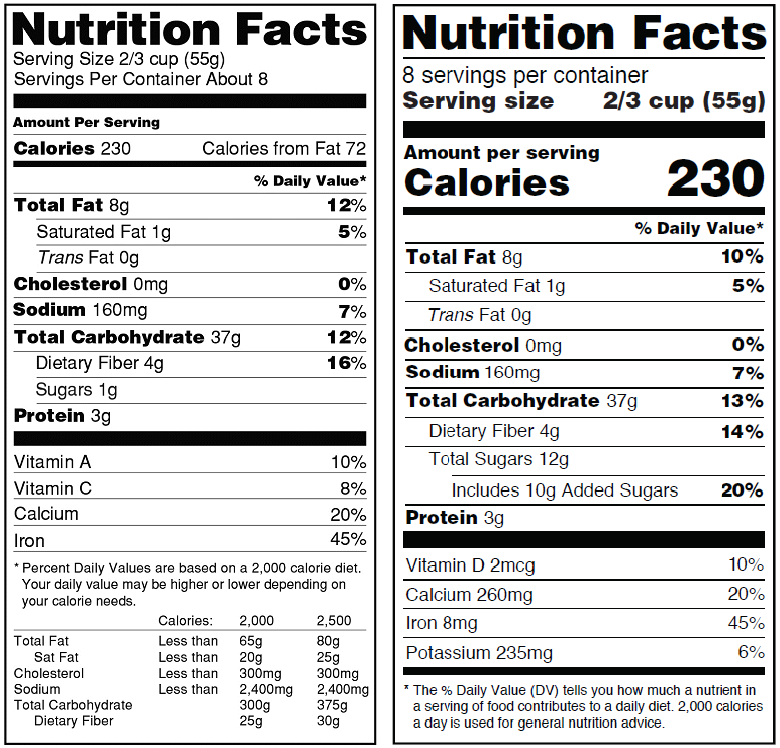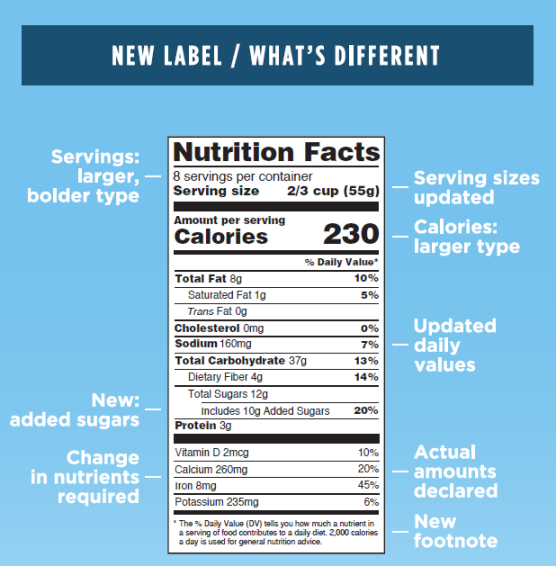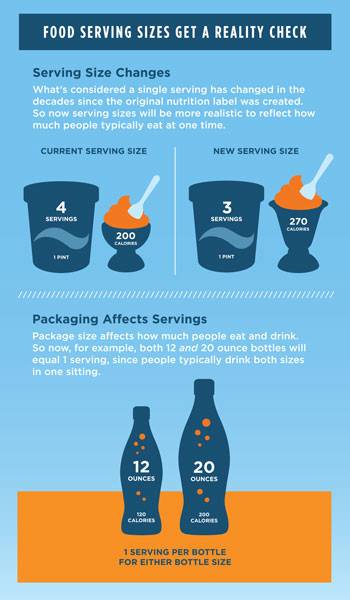
2018 Nutrition Label Requirements
May 20, 2016
The FDA today finalized the new Nutrition Facts label for packaged foods to reflect new scientific information, including the link between diet and chronic diseases such as obesity and heart disease. The new label will make it easier for consumers to make better informed food choices.
Label Format: Original vs. New

Highlights of the Final Nutrition Facts Label
1.) Features a Refreshed Design
- The “iconic” look of the label remains, but we are making important updates to ensure consumers have access to the information they need to make informed decisions about the foods they eat. These changes include increasing the type size for “Calories,” “servings per container,” and the “Serving size” declaration, and bolding the number of calories and the “Serving size” declaration to highlight this information.
- Manufacturers must declare the actual amount, in addition to percent Daily Value of vitamin D, calcium, iron and potassium. They can voluntarily declare the gram amount for other vitamins and minerals.
- The footnote is changing to better explain what percent Daily Value means. It will read: “*The % Daily Value tells you how much a nutrient in a serving of food contributes to a daily diet. 2,000 calories a day is used for general nutrition advice.”
2.) Reflects Updated Information about Nutrition Science
- “Added sugars,” in grams and as percent Daily Value, will be included on the label. Scientific data shows that it is difficult to meet nutrient needs while staying within calorie limits if you consume more than 10 percent of your total daily calories from added sugar, and this is consistent with the 2015-2020 Dietary Guidelines for Americans.
- The list of nutrients that are required or permitted to be declared is being updated. Vitamin D and potassium will be required on the label. Calcium and iron will continue to be required. Vitamins A and C will no longer be required but can be included on a voluntary basis.
- While continuing to require “Total Fat,” “Saturated Fat,” and “Trans Fat” on the label, “Calories from Fat” is being removed because research shows the type of fat is more important than the amount.
- Daily values for nutrients like sodium, dietary fiber and vitamin D are being updated based on newer scientific evidence from the Institute of Medicine and other reports such as the 2015 Dietary Guidelines Advisory Committee Report, which was used in developing the 2015-2020 Dietary Guidelines for Americans. Daily values are reference amounts of nutrients to consume or not to exceed and are used to calculate the percent Daily Value (% DV) that manufacturers include on the label. The %DV helps consumers understand the nutrition information in the context of a total daily diet.
3.) Updates Serving Sizes and Labeling Requirements for Certain Package Sizes
- By law, serving sizes must be based on amounts of foods and beverages that people are actually eating, not what they should be eating. How much people eat and drink has changed since the previous serving size requirements were published in 1993. For example, the reference amount used to set a serving of ice cream was previously 1/2 cup but is changing to 2/3 cup. The reference amount used to set a serving of soda is changing from 8 ounces to 12 ounces
- Package size affects what people eat. So for packages that are between one and two servings, such as a 20 ounce soda or a 15-ounce can of soup, the calories and other nutrients will be required to be labeled as one serving because people typically consume it in one sitting.
- For certain products that are larger than a single serving but that could be consumed in one sitting or multiple sittings, manufacturers will have to provide “dual column” labels to indicate the amount of calories and nutrients on both a “per serving” and “per package”/“per unit” basis. Examples would be a 24-ounce bottle of soda or a pint of ice cream. With dual-column labels available, people will be able to easily understand how many calories and nutrients they are getting if they eat or drink the entire package/unit at one time.
Compliance Dates
- Manufacturers will need to use the new label by July 26, 2018. However, manufacturers with less than $10 million in annual food sales will have an additional year to comply.
Old vs New - What's Different

Serving Size Changes
What's considered a single serving has changed in the decades since the original nutrition label was created. So now serving sizes will be more realistic to reflect how much people typically eat at one time.

Questions & Answers
Why are you changing the Nutrition Facts label?
The current label is more than 20 years old. In order to make sure consumers have access to more recent and accurate nutrition information about the foods they are eating, it’s time to make changes to the Nutrition Facts label. The changes announced today are based on updated scientific information, new nutrition and public health research, more recent dietary recommendations from expert groups, and input from the public.
What major changes are you making?
The changes include modifying the list of required nutrients that must be declared on the label, updating serving size requirements, and providing a refreshed design. The new Nutrition Facts label will make it easier for consumers to make informed decisions about the food they eat.
Why must “added sugars” now be included?
The scientific evidence underlying the 2010 and the 2015-2020 Dietary Guidelines for Americans support reducing caloric intake from added sugars; and expert groups such as the American Heart Association, the American Academy of Pediatrics, the Institute of Medicine and the World Health Organization also recommend decreasing intake of added sugars.
In addition, it is difficult to meet nutrient needs while staying within calorie requirements if you consume more than 10 percent of your total daily calories from added sugars. On average, Americans get about 13 percent of their total calories from added sugars, with the major sources being sugar-sweetened beverages (including soft drinks, fruit drinks, coffee and tea, sport and energy drinks, and alcoholic beverages) and snacks and sweets (including grain-based desserts, dairy desserts, candies, sugars, jams, syrups, and sweet toppings).
The FDA recognizes that added sugars can be a part of a healthy dietary pattern. But if consumed in excess, it becomes more difficult to also eat foods with enough dietary fiber and essential vitamins and minerals and still stay within calorie limits. The updates to the label will help increase consumer awareness of the quantity of added sugars in foods. Consumers may or may not decide to reduce the consumption of certain foods with added sugars, based on their individual needs or preferences.
The final rule requires “Includes X g Added Sugars” to be included under “Total Sugars” to help consumers understand how much sugar has been added to the product.
How does the FDA define “added sugars”?
The definition of added sugars includes sugars that are either added during the processing of foods, or are packaged as such, and include sugars (free, mono- and disaccharides), sugars from syrups and honey, and sugars from concentrated fruit or vegetable juices that are in excess of what would be expected from the same volume of 100 percent fruit or vegetable juice of the same type. The definition excludes fruit or vegetable juice concentrated from 100 percent fruit juice that is sold to consumers (e.g. frozen 100 percent fruit juice concentrate) as well as some sugars found in fruit and vegetable juices, jellies, jams, preserves, and fruit spreads.
For industry and those interested in the more technical version of the definition, please consult page 897 of the Nutrition Facts Label Final Rule.
Are you using the new label to tell people what to eat?
The Nutrition Facts label is designed to provide information that can help consumers make informed choices about the food they purchase and consume. It is up to consumers to decide what is appropriate for them and their families’ needs and preferences.
Why is trans fat still on the label if the FDA is phasing it out?
Trans fat will be reduced but not eliminated from foods, so FDA will continue to require it on the label. In 2015, the FDA published a final determination that partially hydrogenated oils (PHOs), the source of artificial transfat, are not generally recognized as safe, but this determination would not affect naturally occurring trans fat, which would still exist in the food supply. Trans fat is present naturally in food from some animals, mainly ruminants such as cows and goats. Also, industry can currently use some oils that are approved as food additives and can still petition FDA for certain uses of PHOs.
Why are vitamin D and potassium being added to the Nutrition Facts label?
Vitamin D and potassium are nutrients Americans don't always get enough of, according to nationwide food consumption surveys, and when lacking, are associated with increased risk of chronic disease. Vitamin D is important for its role in bone health, and potassium helps to lower blood pressure. Calcium and iron are already required and will continue to be on the label.
Why are you no longer requiring vitamins A and C?
In the early 1990’s, American diets lacked Vitamins A and C, but now Vitamins A and C deficiencies in the general population are rare. Manufacturers are still able to list these vitamins voluntarily.
Will the new label look different?
You will still recognize the label, but we have made some improvements to the format to provide significant public health information. Changes include:
- Highlighting “Calories,” “servings per container,” and the “Serving size” declaration by increasing the type size and placing the number of calories and the “Serving size” declaration in bold type.
- Requiring manufacturers to declare the actual amount, in addition to percent Daily Value, of the mandatory vitamins and minerals.
- Adding “Includes X g Added Sugars” directly beneath the listing for “Total Sugars.”
- Changing the footnote to better explain the percent Daily Value. It will now read: “*The % Daily Value tells you how much a nutrient in a serving of food contributes to a daily diet. 2,000 calories a day is used for general nutrition advice.”
I heard that some serving sizes will actually be bigger. That doesn’t seem to make sense with the obesity epidemic.
Some serving sizes will increase and others will decrease because by law, the serving sizes must be based on the amounts of food and drink that people typically consume, not on how much they should consume. Recent food consumption data show that some serving sizes need to be revised. For example, the reference amount used to set a serving of ice cream was previously 1/2 cup and now is changing to 2/3 cup. The reference amount used to set a serving size of soda was previously 8 ounces and now is changing to 12 ounces. The reference amount for yogurt is decreasing from 8 ounces to 6 ounces. Nutrient information on the new label will be based on these updated serving sizes so it matches what people actually consume.
How much time will manufacturers have to make these changes?
Manufacturers will have until July 26, 2018 to comply with the final requirements, and manufacturers with less than $10 million in annual food sales will have an additional year to make the changes.
Will the new requirements apply to imported food?
Yes, foods imported to the United States will need to meet the final requirements.